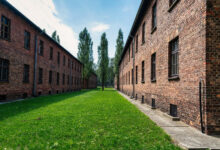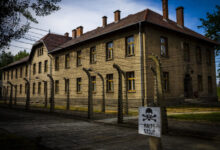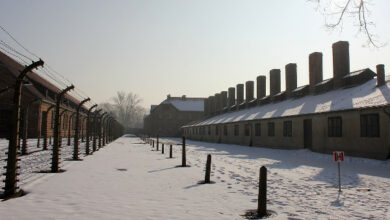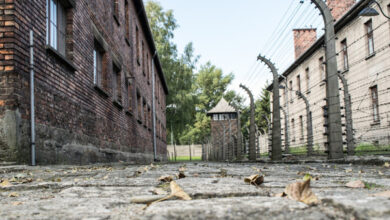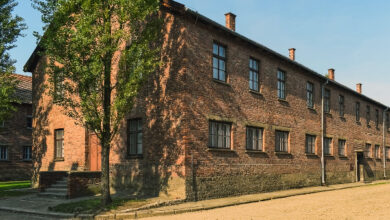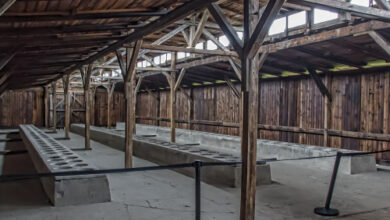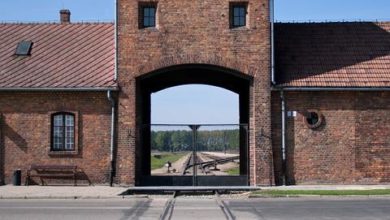Auschwitz III–Monowitz
The History and Legacy of the Nazi War Industrial Camp Auschwitz III–Monowitz
Auschwitz III–Monowitz, often referred to simply as Monowitz, served as both a concentration and labour camp during World War II. Operating from 1942 to 1945, it was a critical part of the Auschwitz complex. This complex was the most extensive network of concentration and extermination camps established by Nazi Germany in occupied Poland.
Unlike the main camp of Auschwitz I and the extermination camp of Birkenau (Auschwitz II), Monowitz was primarily constructed to fulfil the workforce needs of the German chemical conglomerate IG Farben.
Understanding of the Holocaust includes recognising that Monowitz was one of the first sub-camps within the Auschwitz system, eventually becoming one of the largest. Over its operational period, it evolved to serve as the base for the industrial sub-camps where prisoners faced brutal working conditions.
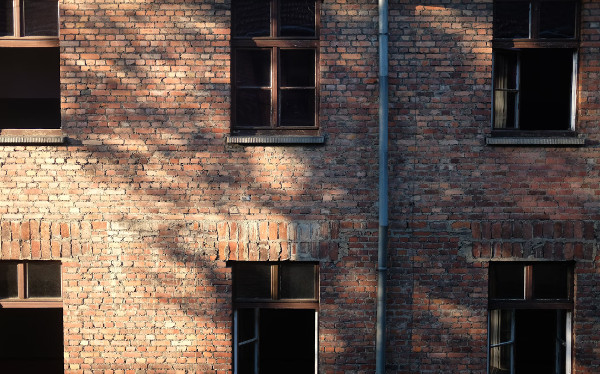
Administered by the SS, Monowitz provided forced labour to the Buna-Werke plant, focusing on rubber production, which was critical to the German war effort.
The conditions at Monowitz were harsh and dehumanising. The survival of its inmates was continually threatened by the combination of forced labour, insufficient nutrition, and the violent regime of the SS guards. The camp’s command structure aligned with the overarching hierarchy of the Auschwitz complex and was integral to the Nazi’s genocidal machinery that exacted a grievous toll on human lives during the Holocaust.
Table of Contents:
Historical Context of Auschwitz III–Monowitz
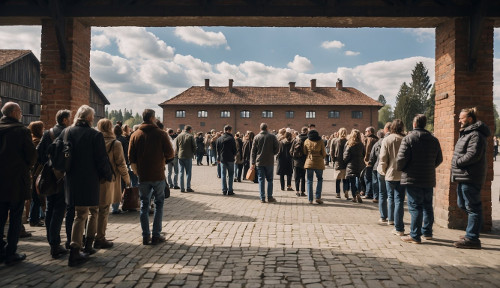
In this section, you will explore the origins of the Auschwitz III–Monowitz camp within the broader framework of Nazi Germany’s expansion and the establishment of the Auschwitz complex.
Rise of Nazi Germany
The Nazi Party, led by Adolf Hitler, rose to power in Germany in 1933. This period marked the beginning of the Third Reich, where sweeping political, social, and economic changes took place.
Under the Nazi regime, Germany pursued aggressive territorial expansion, leading to the occupation of Poland in 1939 and the onset of World War II. The ideological cornerstone of Hitler’s regime was the implementation of a racially defined hierarchy that singularly targeted Jews and other groups for persecution.
Formation of Auschwitz Complex
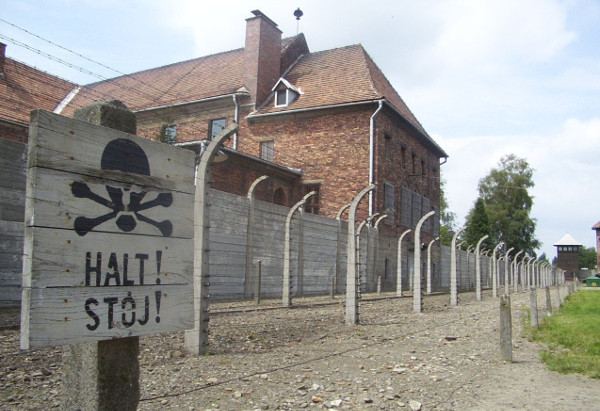
The Auschwitz concentration camp complex was one of the most infamous symbols of the Holocaust. Auschwitz I was founded in occupied Poland in 1940, initially serving as a detention centre for political prisoners.
However, it quickly escalated into a major site of the Nazis’ Final Solution, a plan for the systematic extermination of the Jewish population. The complex expanded to include Auschwitz II-Birkenau, a dedicated extermination camp, and Auschwitz III–Monowitz, a labour camp established to serve the nearby Buna-Werke (IG Farben) industrial plant.
Check also articles:
Foundation of Monowitz

In the early 1940s, you witnessed the grim conjunction of industry and genocide with the establishment of Monowitz, a camp specifically built to fulfil the requirements of industrial giants.
IG Farben’s Influence
IG Farben, a powerful German chemical conglomerate, played a pivotal role in the establishment of Monowitz, which is also known as Auschwitz III. Situated near Monowice in occupied Poland, the outpost was created to house workers for its ambitious project.
IG Farben invested in synthetic rubber and other chemical productions, recognising the strategic importance of these resources in wartime. The decision to place their new factory near Auschwitz was influenced by various factors:
- Accessibility to raw materials: Key to IG Farben’s operations, particularly in the production of synthetic rubber.
- Proximity to forced labour: The availability of prisoners from the Auschwitz camps was a grotesque boon to their industrial efforts.
- Infrastructure: Adequate rail connections facilitated the transport of both materials and labour.
Establishment of Buna Werke
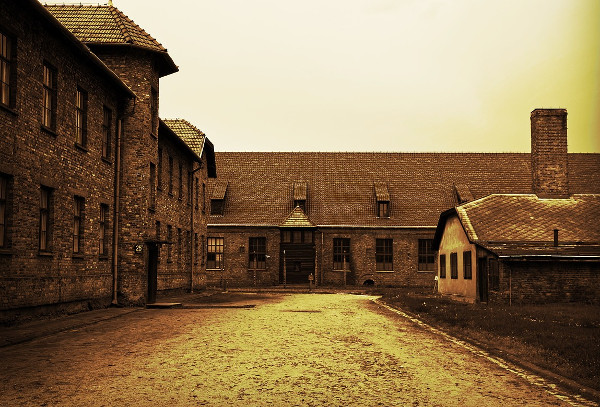
The construction of the Buna Werke factory began as part of IG Farben’s expansion. This complex was focused on producing Buna, a synthetic rubber vital to the war effort.
Buna Werke quickly became a nexus of suffering and exploitation, as prisoners from Auschwitz were forced to work under inhumane conditions.
- Factories involved: Alongside Buna Werke, you’d find companies like Siemens-Schuckert and Krupp deeply entrenched in the industrial fabric of Monowitz.
- Products: Synthetic rubber was the primary product, but the chemical landscape included other pivotal wartime necessities.
- Impact on production: While IG Farben intended to maximise their output with the use of forced labour, the harsh realities and inhumane working conditions often led to a less than optimal production rate and the weakening and demise of countless innocent lives.
Life in Monowitz
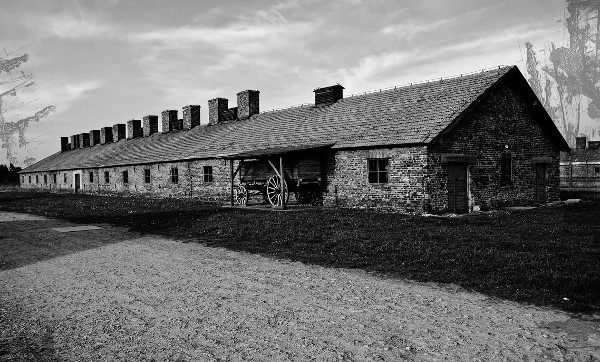
In Monowitz, your life would have been governed by severe conditions and the constant presence of death. Both physical and mental endurance would have been essential for survival.
Daily Conditions and Labour
Daily Life: You would commence your day with an early roll call, followed by long hours of arduous labour. Prisoner were compelled to work in the Buna-Werke factory, which was part of the synthetic rubber production enterprise of IG Farben. Productivity at Monowitz camp was monitored by both SS guards and factory management.
- Work Conditions: Labour tasks were grueling, and prisoners were expected to work regardless of their health condition. Foremen and capos, often selected from the prisoner hierarchy, played significant roles in your daily life, as they were responsible for supervising work and could inflict brutal punishments.
Prisoner Hierarchy
Hierarchy: Life in Monowitz was heavily influenced by a prisoner hierarchy, where capos held power over other inmates, often as a means of survival. They were prisoners elevated to supervisory positions and were known for their harsh treatment of fellow inmates.
Capos and their Role: The capos would have been responsible for organising you and other prisoners into work details and ensuring quotas were met. Invariably, they were intermediaries between the SS and the prisoners.
Health and Mortality
Healthcare: Medical assistance within Monowitz was largely a facade. The camp had a hospital, but it was primarily a place where prisoners would be assessed for their ability to work. If deemed unfit, they could face death by murder, including lethal injection with phenol.
Mortality: The life expectancy of a prisoner in Monowitz varied, but many were murdered or succumbed to the brutal conditions. Disease and starvation were rampant, and prisoners would constantly be at risk of extermination.
Notable Figures Auschwitz III–Monowitz
In the context of Auschwitz III–Monowitz, notable figures span both the perpetrators, such as commandants and officials, and the victims, including prominent inmates who later became influential witnesses to the atrocities committed there.
Commandants and Officials
Heinrich Schwarz served as the commandant of Auschwitz III–Monowitz throughout its operation. As an SS-Hauptsturmführer, Schwarz oversaw the sub-camp that was specifically tied to the interests of IG Farben, a company complicit in the exploitation of forced labour for industrial purposes.
Commandant:
- SS-Hauptsturmführer Heinrich Schwarz (entire existence of the camp)
IG Farben Officials:
- Executives and administrators collaborated with the SS, utilising the camp for slave labour.
Prominent Inmates
Among the many subjected to the unbearable conditions of Auschwitz III–Monowitz were individuals who would survive to recount the horrors they witnessed and endured.
- Primo Levi: An Italian Jewish chemist, writer, and Holocaust survivor; he later authored several books about his experiences, including the acclaimed “If This Is a Man”.
- Elie Wiesel: A Romanian-born American writer, professor, political activist, Nobel Laureate, and Holocaust survivor; known for his memoir “Night”, detailing his experience with his father in the Nazi concentration camps.
- Fritz Löhner-Beda: An Austrian lyricist, librettist, and writer who was also incarcerated in the camp.
The Holocaust and Auschwitz III–Monowitz
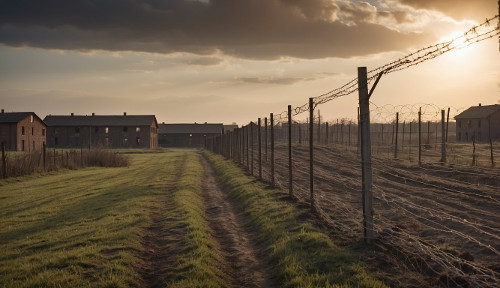
During the Holocaust, Auschwitz III–Monowitz represented one of the most lethal manifestations of Nazi Germany’s extermination network, functioning both as a labour and death site.
Auschwitz Network and Genocide
Auschwitz III–Monowitz was a component of the larger Auschwitz concentration camp complex. The latter included Auschwitz I (the main camp) and Auschwitz II-Birkenau, the latter being the primary extermination site where mass killings occurred.
Your understanding of the Holocaust’s brutality is incomplete without recognizing the role of Monowitz, also referred to as Buna, in the systematic genocide of Jews and other groups.
Monowitz was established in 1942 and was distinctive amongst the Auschwitz camps for its industrial ties, notably with IG Farben industries.
Monowitz did not contain gas chambers like Auschwitz II-Birkenau, but the conditions were dire and led to a high death toll through exhaustion, malnutrition, and violence.
The camp was instrumental in the Nazis’ “Final Solution” – the plan to annihilate the Jewish population of Europe.
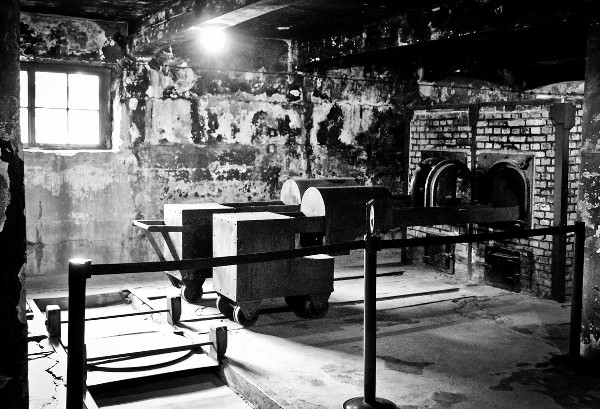
Role in the ‘Final Solution’
You must grasp that Auschwitz III–Monowitz played a pivotal role in the industrialised aspect of the genocide. The camp was directly involved in the exploitation of forced labour for the war effort, which was a crucial element of the ‘Final Solution’.
Prisoners, many of whom were Jews transported from ghettos and other camps, underwent a selection process. Those not sent directly to extermination were subjected to slave labour under inhumane conditions.
Deemed part of the Final Solution to the so-called “Jewish Question”, the existence of Monowitz highlights the extent of the Nazis’ plan to not only exterminate Jews but also utilise them as forced labour until death.
The Einsatzgruppen, mobile killing units, and extermination camps like Auschwitz-Birkenau, were complements to this system of genocide that you witness at Monowitz, where many faced their deaths from overwork and violence.
Auschwitz III–Monowitz Liquidation and Aftermath
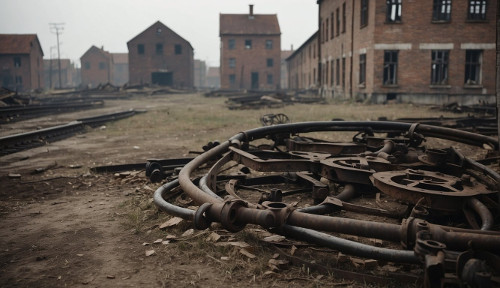
In January 1945, as the Red Army approached, the SS hastily evacuated Auschwitz III–Monowitz, forcing the prisoners on death marches towards other camps.
Liberation by Soviet Troops
On 27 January 1945, Soviet troops liberated Auschwitz-Birkenau, the parent camp of Monowitz. The Red Army found the site mostly abandoned, with a few thousand sick and dying prisoners who had been left behind.
Many of the Monowitz inmates had already been forced on marches that led to Sachsenhausen and Dachau, among other camps.
Post-War Trials and Remembrance
Following the war, several high-ranking officials responsible for the various camps were held accountable for their actions at the post-war trials.
The remembrance of Auschwitz III-Monowitz is preserved through memorials and educational programs, ensuring that the atrocities committed there are not forgotten.
Your engagement with history involves honouring the victims and learning about the past to prevent the recurrence of such inhumanity.
Monowitz in Modern Memory
In keeping with the significance of its history, Monowitz is remembered through various forms of literature and educational efforts that aim to bolster public awareness of its past.
Literature and Documentations
If This Is a Man, a seminal work by Primo Levi, deftly catalogues the harrowing experiences within the Auschwitz concentration camp system, specifically drawing from the author’s personal ordeal.
Your understanding of Monowitz’s legacy is further deepened with Night, Elie Wiesel’s poignant narrative.
These accounts serve not only as historical documentations but also as a stark reminder of the atrocities committed.
- Primo Levi’s If This Is a Man: Captures intricacies of camp life.
- Elie Wiesel’s Night: Offers visceral, first-hand insight into the Holocaust experience.
Public Awareness and Education
Recognition of Monowitz’s place in history is expanded through educational frameworks and increased public awareness.
Institutions worldwide implement educational programmes to ensure the history of the Auschwitz concentration camp is conveyed accurately and responsibly.
- Educational Initiatives: Detailed curricula on Holocaust history.
- Public Awareness: Commemorations and exhibitions promoting understanding.
Historical Significance and Debates
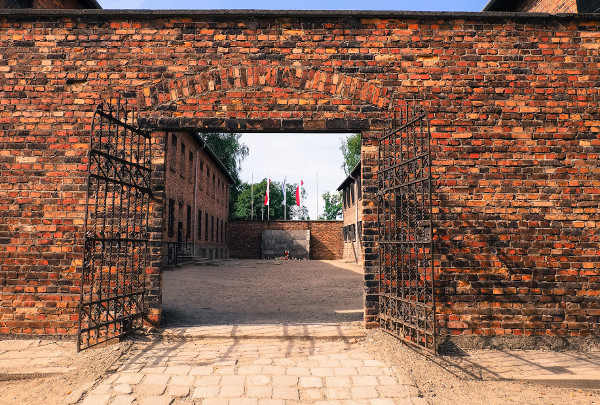
As you explore the topic of Auschwitz III–Monowitz, consider its complex place within history and the various interpretations that continue to evolve.
Post-War Analysis
The historical significance of Auschwitz III-Monowitz, often obscured by the sheer scale of Auschwitz-Birkenau, lies in its exemplification of the Nazi economic exploitation of forced labour.
After the liberation of concentration camps, detailed analysis by scholars highlighted the intertwining of industrial endeavours with systematic human rights abuses at Monowitz.
- Economic function: Monowitz served the Nazi regime primarily as a site for forced labour to support the war effort.
- Mortality rates: Harsh working conditions combined with inadequate food and medical care led to high mortality among prisoners.
The SS liberally documented the camp, providing post-war researchers with extensive material that evidences its operation and the atrocities committed.
Contemporary Interpretations
In more recent years, debates have emerged which question the narrative and representations of Auschwitz and its sub-camps.
The focus on survivor testimonies has shifted to a more pluralistic reading of the camps’ history, juxtaposing victims’ experiences with the economic and administrative apparatus that enabled the Holocaust.
Controversial aspects arise around issues such as:
- The morality of using forced labour in connection with multinational corporations.
- Commemoration practices and the ethical responsibilities of modern companies to their historical involvement at camps like Monowitz.
Monowitz’s role within Auschwitz is a subject of continued research, and new findings sometimes challenge established understandings.
Read also:
- Airports Near Auschwitz
- Arbeit Macht Frei Meaning
- Auschwitz and Wieliczka Tour from Krakow
- Auschwitz and Zakopane Tour
- Auschwitz Krakow Weather
- Auschwitz Tour with Hotel Pick-up
- Book Trip to Auschwitz
- How Much is the Entry Fee for Auschwitz?
- How to Book Auschwitz Tour?
- How to Get to Auschwitz
- Was Treblinka Worse than Auschwitz?
Industrial Impact of Monowitz
Exploration of Auschwitz III–Monowitz, specifically the industrial complex known as Buna-Werke, will reveal its significant contributions to the German war machine and the inhumane exploitation of resources, including forced labour.
Economic Contributions
The Buna-Werke, named after the synthetic rubber “Buna”, was the cornerstone of Monowitz’s economic contributions.
This industrial site operated by I.G. Farben played a pivotal role in synthesising materials necessary for the Nazi war effort.
- Synthetic Rubber Production: The facility was crucial in developing alternate materials like synthetic rubber, deemed essential due to the Allied blockades that cut off natural rubber supplies.
- Zyklon B: The infamous chemical Zyklon B, used tragically in gas chambers, was also a product of the chemical industries tied to the camp.
- Coal: Nearby coal mines, like the one in Dwory, provided the raw materials necessary for running the Buna-Werke and other associated facilities.

